
You are looking at a modern miracle. In the upper left hand corner is the ubiquitous Apple Computer symbol. This is a 17″ Macbook computer running Windows and Mac programs at the same time.
Steve and Linda write a regular column for SetSailors from wherever they happen to be. Join in as they cruise the world and discuss topics of interest to sailors everywhere. Here you’ll find their articles dating from 1996 to the present.

You are looking at a modern miracle. In the upper left hand corner is the ubiquitous Apple Computer symbol. This is a 17″ Macbook computer running Windows and Mac programs at the same time.
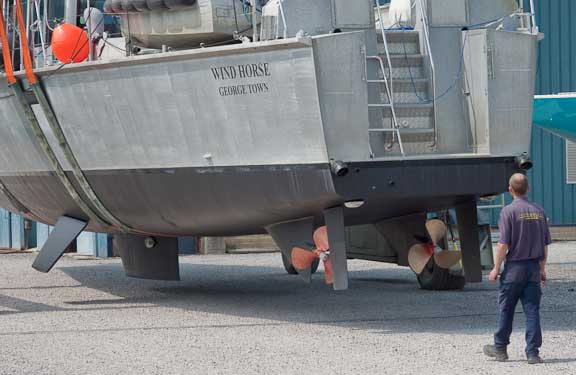
Here is a welcome sight after eight long months – Wind Horse hanging in the Travel Lift slings at Berthons in the UK, ready to launch. Notice anything different?
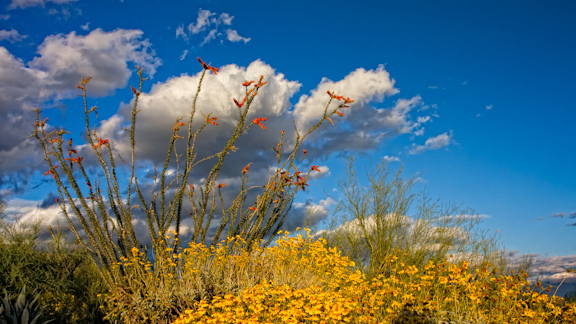
Spring is in the air and for us this is a welcome change. The past four years we’ve been away at this time of year, testing the FPB prototype, and have missed this part of Nature’s cycle. For those of you who think the Sonora desert is bleak, we have put together a slide show of what it presently looks like in our Tucson, Arizona, neighborhood. All of these photos were taken either on our property, or within a ten minute walk.
One of the areas we survey each year before starting to cruise is communications. There are a variety of approaches to this question, and the correct answer depends on cruising grounds and the need to stay in touch.
In our case there are several requirements:
We’ve been wrestling with the route west for Wind Horse and crew. There are good reasons for each of the options we discussed back in February. The decision has been simmering in the background, and only started thinking about a route decision a few weeks ago.

The subject of where to put communications gear comes up often. With its formal office area the FPB 64 has the option of mounting this gear other than at the bridge where space is always at a premium. But does this make sense?
![]()
You may have noticed the posts have slowed down. We’ve been working on a high definition online slide show and video of the FPB 64 sea trials. They are now live.
The video be accessed by clicking here.
Click here for the slide show.
Enjoy…
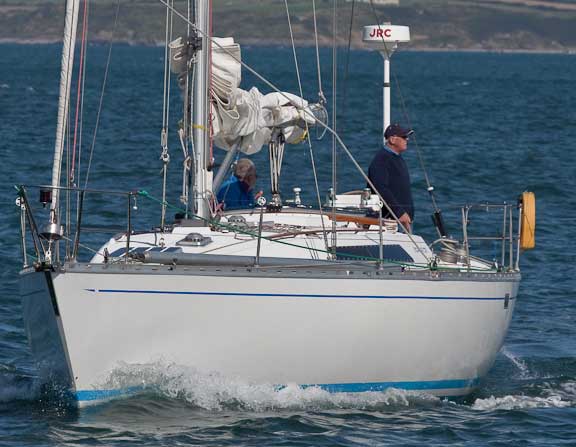
What is the optimum height for a radar antenna? It is a debate that goes on 40 years after radars started being installed on yachts.
Lets review the issues:
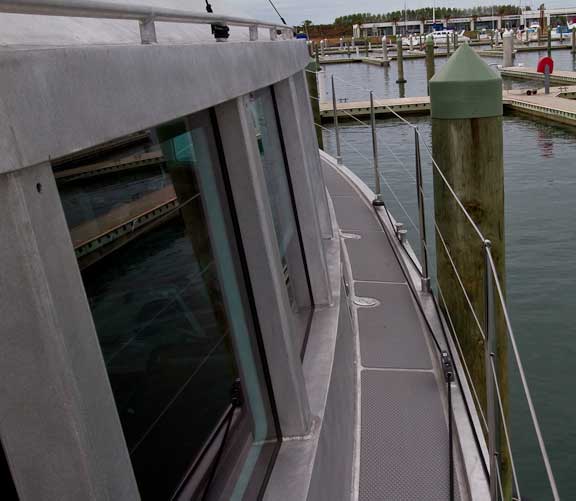
We’ve been experimenting to find the center of lateral resistance (CLR) around which the FPB 64 pivots. Laying against a piling is the perfect way to establish CLR location.
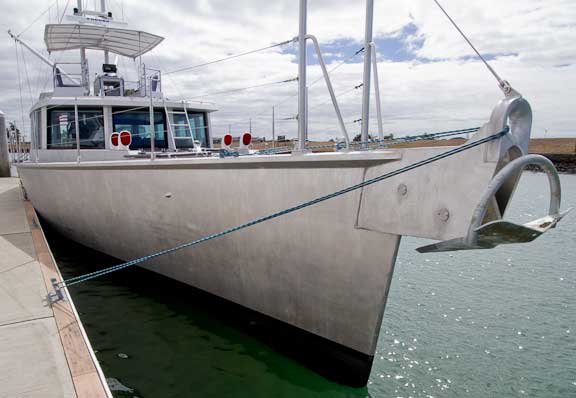
We’ve been using a bow pivot spring for years to rotate off the dock when the wind is holding us on.
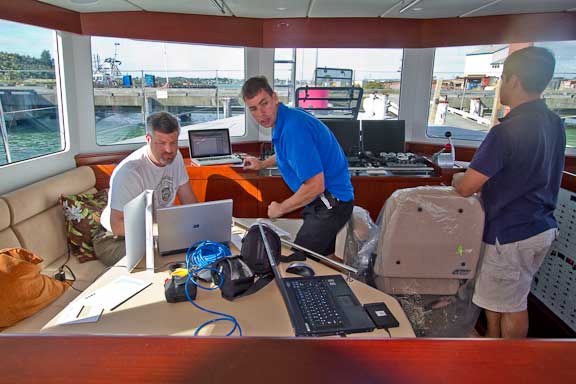
The sea trial process is designed to insure everything works as planned, and to ferret out problems that may be hidden. Most of this will have been done in the shop, before launching. But with custom builds, or the first in a series, the schedule often slips and this work ends up happening afloat (and there are some things which have to be done in the water).
The photo above says something about this process in the 21st century. Count the computers, all of which are in use for commissioning. Todd and Deon are fine tuning the inverter chargers, and have two computers connected to the inverters while Ruben from Furuno is using his PC to initialize the Nav Net 3D system.
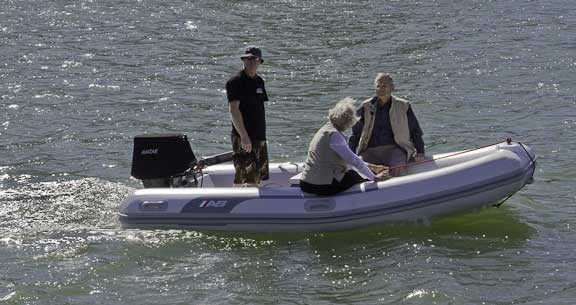
There are a lot of reasons we enjoy what is a very tough business. The creative process is of course a part. But equally important are the relationships established with our clients. Watching their expressions as they see a dream afloat for the first time is a great pleasure.
![]()
Here is a photo we, Circa, and the four sets owners have been waiting for – Avatar, the first of four FPB 64s at anchor.
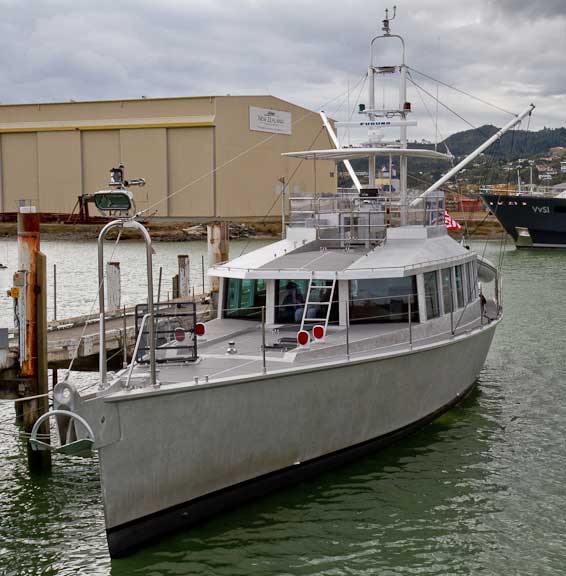
When we see one of our “children” afloat for the first time, in person, it is always a thrill, tinged with apprehension. This time was no different. OK, the FPB 64 looks cool, but what about those thousands of details which go into a project like this, how do they work out?
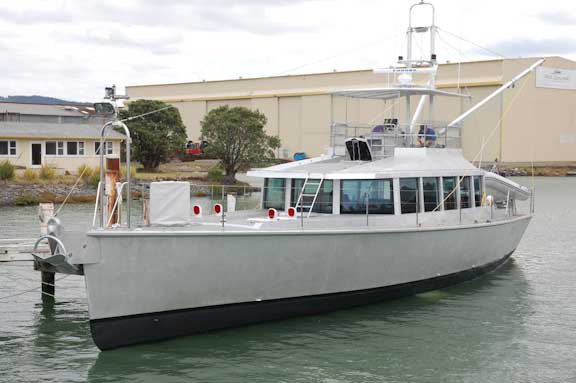
By the time we see a new design afloat we’ve been “pregnant” with it for so long we just want to get the it over with. This process of designing and building is intense, and it really gets pressurized the last six to eight weeks as the builders sort out the last few details and push for launching. But once we and the builders see a photo like this – the boat floating on her lines – and the initial performance data confirms the preliminary concept of three years prior – the effort is worthwhile.
We’ll have lots of information over the next few weeks as we go through sea trials. This will be organized in the three categories below this blog on the front page and sidebar (Sea Trials, FPB Series Notes, and Updates).
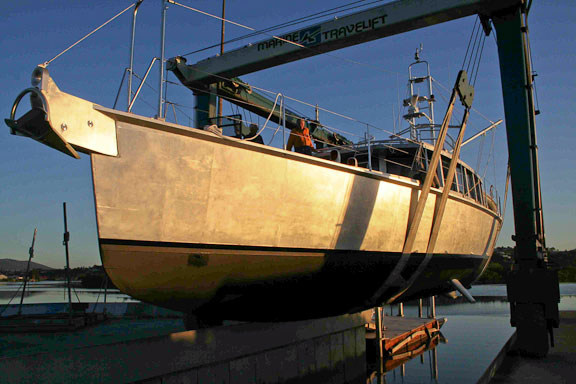
The day we have been waiting for has arrived. FPB 64 number one is hanging in the slings, ready for launch. In the next few hours we will know how she floats, what the handling is like, and if the performance calculations are correct.
Lots more photos coming shortly.
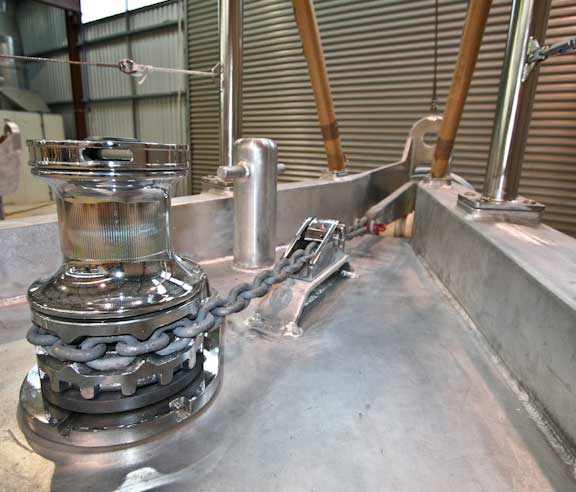
Having the correct fit between chain and anchor winch chain wheel is critical to correct operation. Fit right, as in the photo above, and the chain strips easily coming in and runs out smoothly. If the fit is wrong, the chain will stick in both directions, and tend to build up twists. Chain wheels are also subject to wear, after which the chain does not fit well. After five cruising seasons with the FPB 83 Wind Horse we have just replaced the chain wheel.
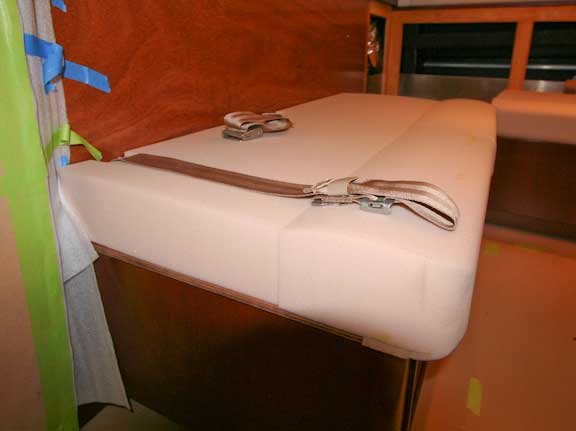
This is going to sound a little strange, but of all the trades involved with building a yacht, the one which has historically given us the biggest headaches have been the upholsters. So far, this has not been a problem with Circa.
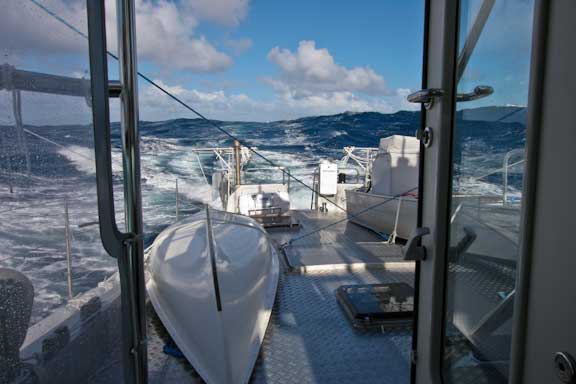
We have been discussing auto pilot requirements with one of our clients and we thought a review of what makes a good pilot system might be of interest to you.
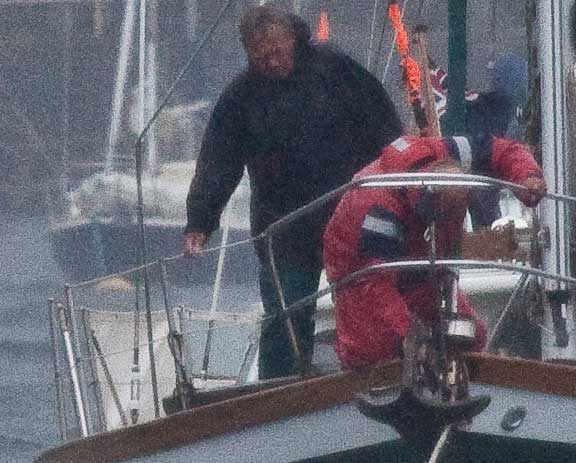
Have a close look at the interaction between the Bruce anchor and the mooring pennant in the bottom right corner of this photo. When thinking about anchor storage consideration must also be given to chafe from:
All of these functions relate to the stowage system for the primary anchor.

It is often hard to find enough space for one let alone two dinghies. So when this motor yacht passed us in Falmouth Harbor in the UK we grabbed the long lens.
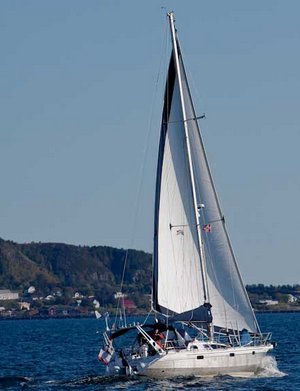
We’ve been noticing these Ovni 43s for years. The hard chine hull with its bare aluminum topsides stands out, and the fact that these boats are designed to sit on land or ice is additionally intriguing.
We saw Lady Salope first in Bergen, Norway,
We’ve been reviewing our logic on chain size and thought a few points might be of interest.
To begin with we have a long and successful history of using heat treated Grade 70 chain. But this gets little respect with a regulatory authority with whom we are discussing the classification of one of our yachts – hence the following comments.
We’ve been talking to various cruising friends and routers about our North Atlantic plans. The northern route via Iceland and Greenland is easy weather wise. Short hops and our boat speed means patience should be rewarded with smooth seas. Likewise the traditional tradewind route via the Canary Islands and West Indies is easy, albeit long.
It is the middle, more direct route about which we want expert opinions. While we always make up our own minds, and the final decision will rest on the weather patterns we see when ready to depart the UK, we like to get an early jump thinking about various scenarios. For part one of this discussion click here .
From time to time we check in with UUPlus for the latest info on satellite communications. This chat turned up several interesting tidbits which may be of interest.
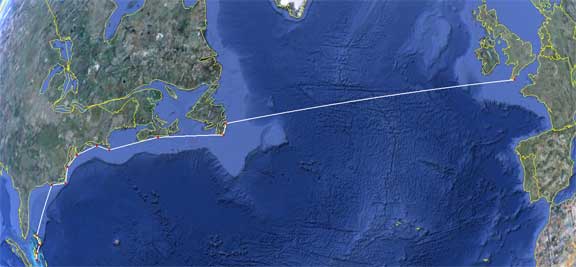
We are starting to ruminate on the upcoming cruising season. In the winter, after hurricane season, we want to be in the Bahamas and spend some time in warm water, sunny weather, with lots of white sand into which we can dig our toes. The question is how do we get there from the United Kingdom?
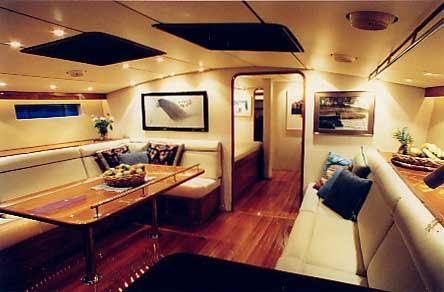
We learned years ago that art work – either paintings or photos – could make a huge difference in the look and feel of a yacht interior, including expanding the visual space. An added benefit is that it is easy to change what is on the bulkheads, giving you a fresh appearance from time to time. The photo above is of the salon in the 78 foot ketch Beowulf. This is a large space, but adding art to the forward bulkhead makes it feel even bigger, in addition to the pleasure of looking at the paintings.
This may seem strange, but when we are working on interior layout how the furniture works with art is a key design consideration.
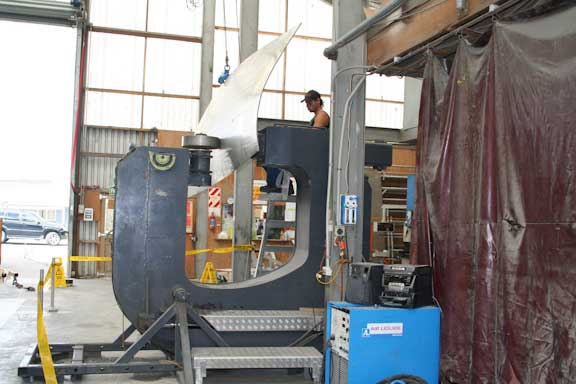
We found a series of photos showing the actual process that Circa uses for shaping hull plate. Their approach is relatively sophisticated and allows us to chose hull shape and plating thickness that are optimized without worrying if the design can actually be fabricated.
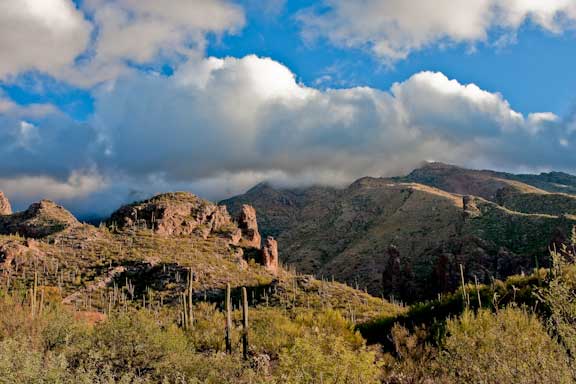
Why would sailors move to Arizona? There are rattlesnakes, gila monsters, scorpions galore, kissing bugs, not to mention javelinas, bears, and even mountain lions. Birds, of the snow and flying variety, flock here in the winter, clogging the arteries.
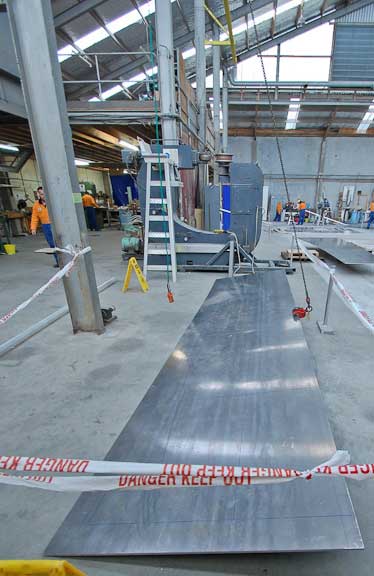
The one question that comes up more often than almost anything else is how do you get a round bilged metal hull? The simple answer is with a great deal of design and engineering thought, and careful work by the builder. We’ve got a series of photos here to briefly walk you through the process.

All diesel fuel carries the ingredients for a nice bloom of algae. This yucky goop can clog filters, and if it works its way into the fuel injection pump, do serious damage. Over the years we have seen lots of cruising yachts with algae problems. But so far, we have avoided this fate.
Algae requires two important items to bloom, water and heat. The heat comes from the excess fuel which the diesel injector pump returns to the tank (it is warmed running through the engine). The moisture is a byproduct of the temperature differential between the tank surfaces and ambient air.
Here are the system and maintenance items that have to date kept us clean:
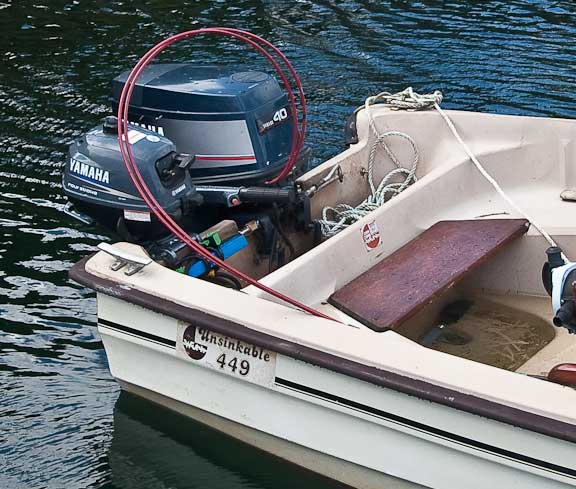
We often use our dinghy as an exploratory vehicle. We carry spares, emergency supplies, GPS, even a small EPIRB. But we have no secondary means of propulsion, other than oars. This is always a nagging concern, even though our 30HP Yamaha two stroke has never given us a problem (nor did its predecessor which served us faithfully for 15 years).
“The hull is much closer to the canoe shape of a yacht than the usual displacement powerboat. Long and narrow, just like their sailboats, the vessel is eye-catching for its purposeful lines…”
–Seahorse Magazine

The hardest part of a hull design to get right is the bow. The tradeoffs that need to be made between upwind comfort and performance and downwind steering control are the same for power and sail. This is an area where computer programs and tank testing are of little value. What you need to do is call on experience and then visualize how the design in question will work in the waves.
To do this you need to understand the design objective, which is what we want to talk about in this blog. We’ll use some photos from the third (above) and fourth (following) FPB 64s under way in New Zealand to illustrate.

Occasionally it is necessary to tie to commercial docks in areas with high tidal ranges. The West Coast of the UK is one such area where tides can range from ten feet (3m) on the low end to 40 feet (12m) or more in parts of Bristol Bay.
Unless you want to be continually adjusting lines, very long bow and stern lines are used as in the photo above. They will be slack at high tide, but as long as the wind is off the end of the boat, or blowing you onto the dock, you will be fine.
If the breeze is off the dock an adjustable breast line is used when going ashore. Much more on this subject will be found in Practical Seamanship.

The ideal helm design should accomplish a number of things:
The design of the FPB 64 helm is based on our experience over the last 45,000 miles with Wind Horse, the approach to which has been refined over the last four years with a series of minor changes.
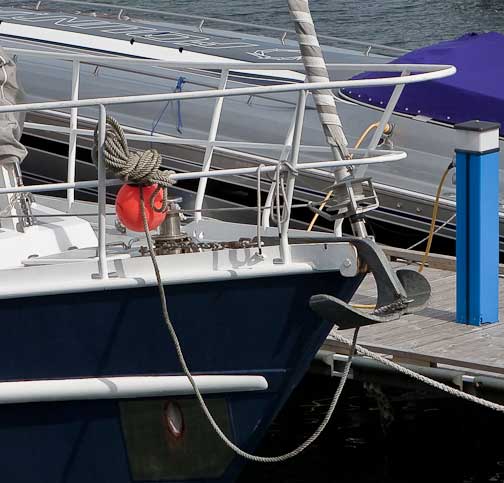
I light of our recent discussions on anchoring, we offer another related topic, buoying the anchor (or not).
Anchor buoys are a complex subject. They offer the advantage of being able to easily free a fouled anchor. But they add a layer of complexity which is not necessarily beneficial.
We’ve previously outlined the advantages of big anchors (shorter scope, less swinging room, security, quicker setting). But we neglected one huge factor, reducing scope reduces the risk of fouling.
Here is an example. Assume you are anchored in forty feet (12m) of water including an allowance for the height of the bow roller off the water.
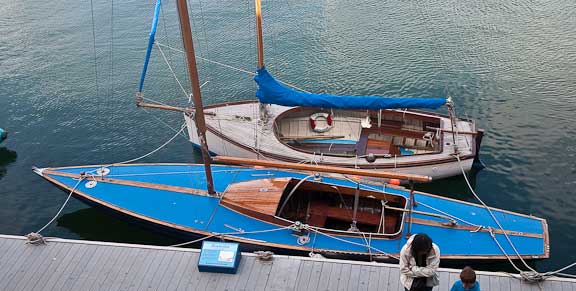
In the olden days before big space or skeg mounted rudders were common the steering forces generated by keel hung rudders were marginal. So the hull shapes had to balance as they heeled or the weather helm would be uncontrollable.
Here are two deck views to show how the lines were typically balanced.

OK history buffs, a stroll through memory lane is in order. We’ve heard from so many SetSail visitors about our multihull notes that we thought some really early stuff might be of interest, mainly triggered by a box of early photos recently discovered.
That is a 17 foot Wildcat above, one of the first two production cats on this side of the Atlantic (Tiger cats were built on the East Coast and Cougar Cats were built in the UK at the same time). We got our first ride on one in Newport Beach, CA, in 1958, and ordered number four. This photo was taken in Marina del Rey about 1962. Note the build out in the marina.
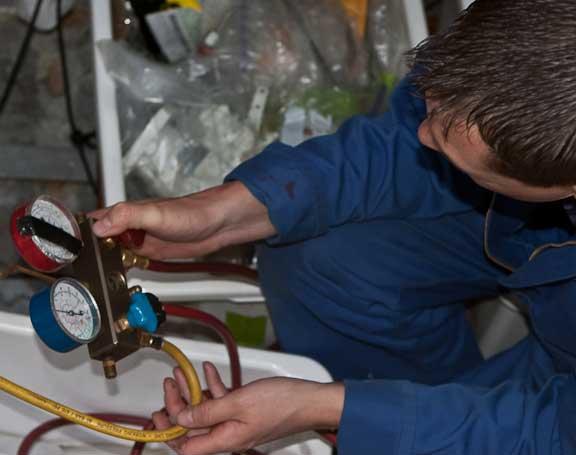
Correct amounts of refrigerant are essential to proper operation of air conditioning equipment (refrigeration too). One sign that a system is low is the evaporator coils (the device which chills the air) will become coated with ice. This reduces air flow and cooling and can lead to compressor damage.
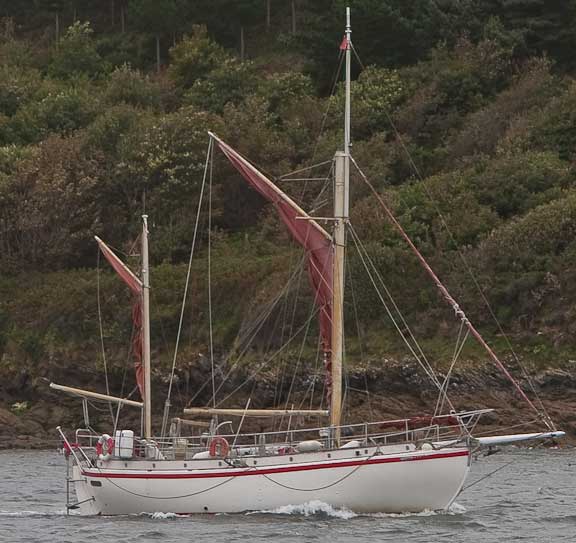
We first noticed this approach to furling on the Thames River barges we saw last spring in London. It is quick and efficient in terms of manpower.
We’ve got six slide shows (with more to come) from our favorite cruising areas. Check back often as we will be adding additional slide shows in the future.
Svalbard, at the top of the world between Arctic Norway and Greenland, is a magical island group. Glaciers, polar bears, walrus, and the Arctic ice pack at 80 degrees north can be experienced by clicking here .
On the other hand there the Bahama Islands. Friendly locals, warm water, and beautiful beaches are the norm here .
Which country has the longest coastline on the planet, wonderful cruising infrastructure, and breathtaking scenery? Click here to cruise Norway with us .
The west coast of Mexico’s Baja California and the Sea of Cortez offer spectacular cruising, great whale watching, and birding. To find out for yourself what these areas are like click here .
Canada’s east coast starting with Nova Scotia offers a unique blend of friendly locals, isolated anchorages, and lovely surroundings. Spend time with us in Nova Scotia, Newfoundland, and Labrador by clicking here .
Interested in the tropical Pacific? Check out the lovely islands of Fiji and Fanning here.
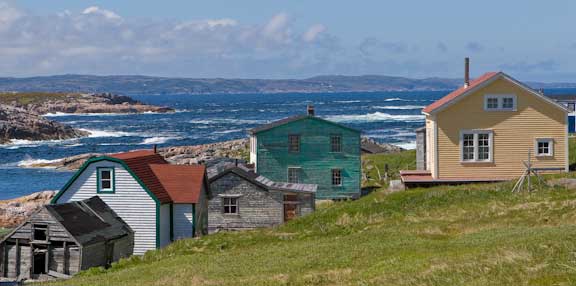
The holiday mood is upon the land and as Circa is taking a well earned (but short) vacation break we will follow suit. Assuming that at some point holiday cheer and endless football will leave you in need of a change, we’ve added to our collection of slide shows. You can view the most recent, on Nova Scotia, Newfoundland, and Labrador by clicking here .

For a sampling of what you will find on a cruise through Norway click here .
Or, if you are behind on your visits to SetSail continue reading this blog for links to lots of other streaming videos and slide shows.
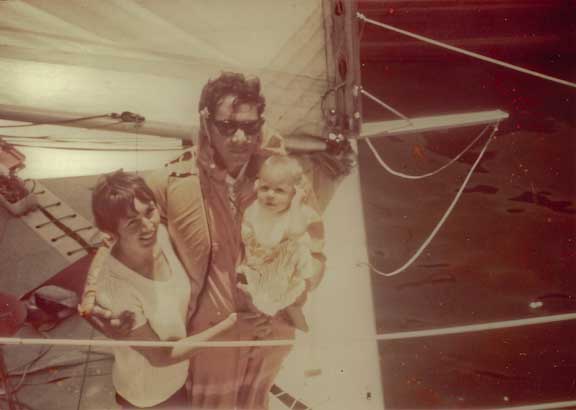
There has been a lot of dialog recently on SetSail about cruising multihulls. Since we were working on some old photos for the kids on this very subject we thought a blog on our early days of cruising might be in order. The photo above was taken 40 years ago. That’s Elyse in Steve’s arms. Two of us are standing on the 32′ D class cat Beowulf V. This was our first “family cruiser” as evidenced by the guest aboard (Linda is considered crew).
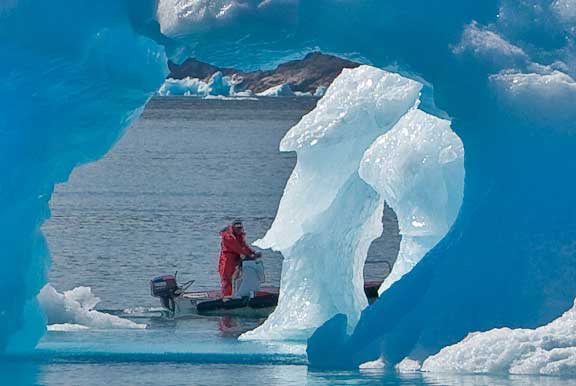
We think that most of the activities to do with cruising are very safe, especially compared to urban life. Of the risks we do face, we consider setting off in the dinghy to be the highest. This was brought home seven years ago at Nantucket Island, on the East Coast of the US.

If you live in the Southwestern U.S. odds are you are going to have to deal with Pack Rats. These destructive critters love to chew on wiring, and when we returned this fall we found an electronic mess. No phones, computer cables chomped (a predilection for USB was noted), even lamp plugs were missing. There’s a maritime connection here.
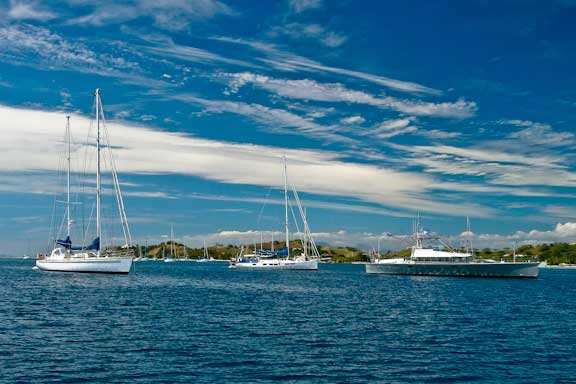
We were working through photos this weekend, putting together more slide shows for our web stream, and came across this photo which might be of interest. It was taken in July of 2005 at Musket Cove in Fiji, a great place to start your winter cruise. The water is just as inviting as the lovely blue sky.
The three boats represent historic milestones of sorts for us.

Sight lines from the helm on a sailboat add the requirement to watch sail trim to the need to see traffic or close under the bow when navigating with debris in the water. When there’s a raised house or large dodge in the equation, the evaluation process gets even tougher.
Take the yacht above. She will have a nicely protected inside steering station. Visibility at sea will be OK except for one factor we will get to shortly.
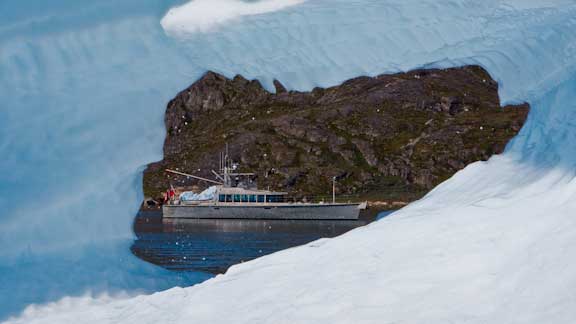
We’ve been trying out some new software which simplifies creating web based slide shows. The first four of these are now posted on our server for your viewing pleasure. You can watch them (together with our videos) by clicking the “Streaming Video” link at the top of the page. Or, you can get to them via the links below.
To watch slide shows of the latest FPB photos, lots of details on Wind Horse , and plus 90 underway and anchored images click here.
We’ve also posted our favorite images of Svalbard (with music) here.
We will be adding to these slide shows weekly, so check back periodically to see the latest.
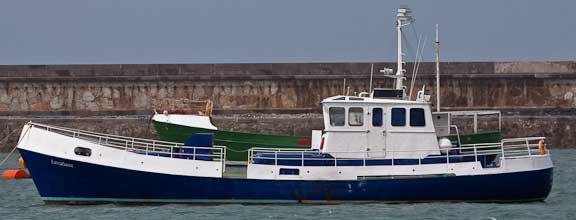
We were waiting out weather in a harbor on the coast of Wales, filled with interesting craft with good examples helm sight lines. A variety of helm positions are in evidence on vessels which almost certainly started life in the commercial realm, but now work at the leisure trades.
This got us to thinking about the complex tradeoffs of optimizing sight lines and comfort; two inherently incompatible requirements.
We’ll start with this handsome vessel.
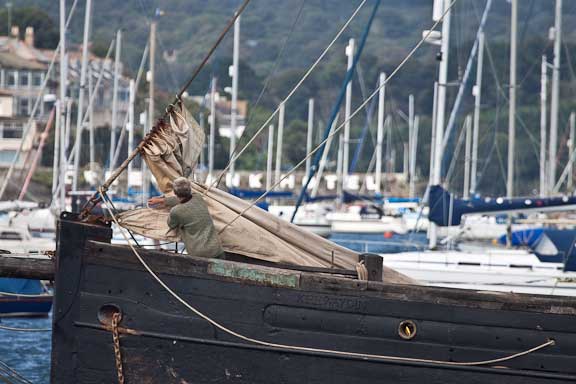
Here’s a Thanksgiving treat for you. We’re looking at the British fishing smack Keewaydin, and one of her two crew members are making a harbor furl of her jib.
She has just sailed in and set her fisherman style anchor alongside Wind Horse so we had a ringside seat to putting her to bed. No roller furling here!

We’ve used rail mounted life rafts on many boats, although usually off the stern. This side mount has some potential problems:

Click here for an article and photos in the October 2009 issue of PassageMaker magazine. (5MB)
“Going with the Flow: An impromptu cruise along Canada’s enchanting East Coast”
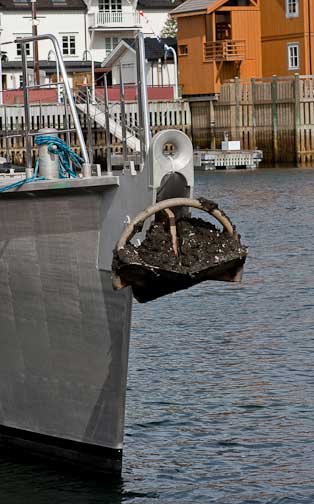
Knowing the type of bottom into which you are setting the anchor is the basis of all decisions from basic security, to the correct scope, and the best anchor to use.
We have recently anchored in three very different set of conditions, so we thought a few comments might be of interest.
On the assumption that you do not know from pilot or guide books the bottom type, the first clue is sound.
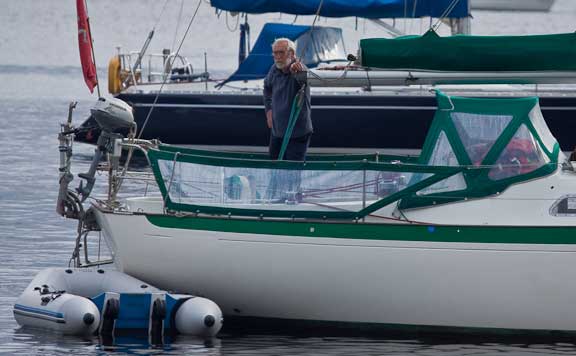
Here is an interesting riff on the traditional cockpit weather cloth. Using dodger window material so you maintain visibility.
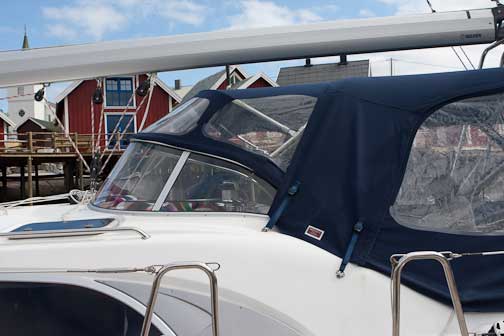
Windshields on sailboats make no sense to us, unless they are incorporated into a dodger design. We shared a dock with this fifty foot (15m) Bavaria in Reine, Norway, and were impressed with the details.

When we were preparing Wind Horse for our cruise to Europe in 2008 we knew that food would be more expensive than the States. So we loaded the basement and freezers (there are two) with everything we could fit.
We thought that you might be interested in what we have found on longevity.

Our aluminum dinghy is now five years old. When we decided to go this route rather than another inflatable we had several objectives. These were:

We were using our clamp meter one morning in Norway to check the Oberdorfer 1/4HP fuel transfer pumps, so we thought we’d mention this very handy tool.
The red lever on the left side, just above the digital read out, opens the red jaws at the top of the meter. You place these around one of the cables, and then read the amperage being used. In this case the motor is drawing 11.4 amps at 24 VDC, just right for a 1/4HP motor under load.
Measuring the amps of any electrical device is a good way to tell if there are problems. If the current is higher than normal, you know further checking is in order.
This meter does both AC and DC. We carry a second meter which is about 1/3rd this size for AC only loads in tight spaces.
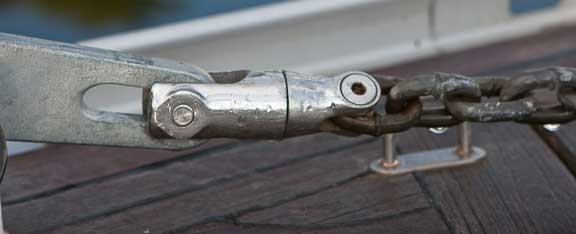
We are not fans of anchor swivels, having seen several disasters due to their failure. This photo clearly shows the problem.
Your anchoring system needs to be consistently engineered, from the bow roller, to the anchor chain connection, the chain itself, chain stopper, and windlass.
Look at the chain in this photo, and compare it to the swivel clevis pins. The steel in the chain is probably a third (at least) stronger than the stainless in the swivel (depending on chain alloy). The links have two legs, equal in diameter to the swivel clevis pins. So the stronger chain alloy has twice the material to carry the load. If you had to pick a weak spot in this system it would be the swivel, which might carry half the load of the chain before failing.
Do you want to bet your boat, and maybe your body on this set up?
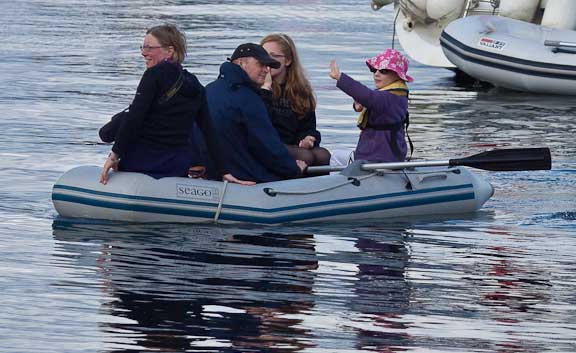
We don’t see a lot of inflatables being rowed these days. Most use outboard propulsion. But when the oars are in use those typically supplied by the dinghy builders are of marginal use.
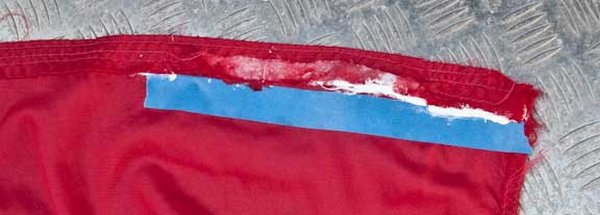
Flags take a beating when you do as many miles as Wind Horse does. So when the trailing edge of our ensign began to unravel we decided to test a system Dan Neri talks about in his book, Sail Care and Repair.
We trimmed off the ragged edges, and then applied some fast cure 5200 adhesive. We used tape to try and keep a neat edge. This fabric is so light that the job was rather messy. But the repair is strong. And we can see where the approach would work really well with sail cloth.
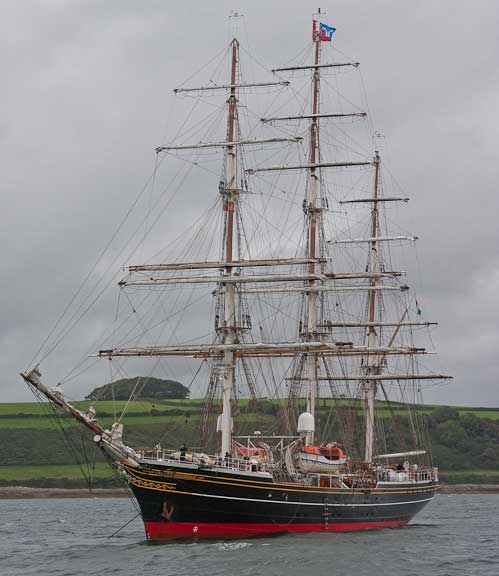
You cannot help but think about the Maritime history in a place like Falmouth. All types of historic naval and commercial craft have called here and anchored in Carrick Roads, as have many famous modern yachts. But in the last several centuries we’d venture nothing cooler than this modern replica of a clipper ship has set her hook off Falmouth harbor.

Engineers who put horizontal oil filters on diesels should condemned to changing these several hundred times, and cleaning up afterwards. If this were the case, they’d figure out how to install these vertically.
So, if you have a Northern Lights genset, as we do, with a horizontal oil filter, the one trick we’ve learned is to poke holes into the filter to partially drain it before removal. This still leaves a mess, just not as big as occurs with a filter full of oil.

Each heat exchanger aboard has its own sacrificial zinc(s). These need to be replaced periodically, some more often than others. The three above are from the stabilizer hydraulic system heat exchangers. They have seen seven months of service.
There are two larger zincs on each diesel, and two smaller zincs on the transmission oil coolers.
Our habit is to change all zincs at the end of each season, or twice a year if the boat stays in salt water for the winter.

We have just gotten around to removing the end caps on our engine heat exchangers. The first time since launching. As you can see, this was somewhat overdue!

Our research into efficient electric cooking continues. This time with an apple pie in the combination microwave/convection oven onboard Wind Horse. The results are encouraging.

Odds are in the marine business that anything that looks new has been done before in some form or other. As partial evidence we offer the following series of photos taken on the Dart River in the UK.
This is the remnants of a World War 11 era Fairmile patrol vessel. These were used for a variety of anti-submarine, coastal patrol, air sea rescue, and clandestine functions. They had to operate in the awful wind and sea states which abound in Europe, so you can assume they were seaworthy.

Life line gates are not complicated, yet often they are improperly detailed. The key element is to provide lateral support where the lifeline wire attaches. This is done by bringing the angled brace right to the top of the stanchion. Note also the flat plate tangs to which the lifelines attach.
On the other hand,
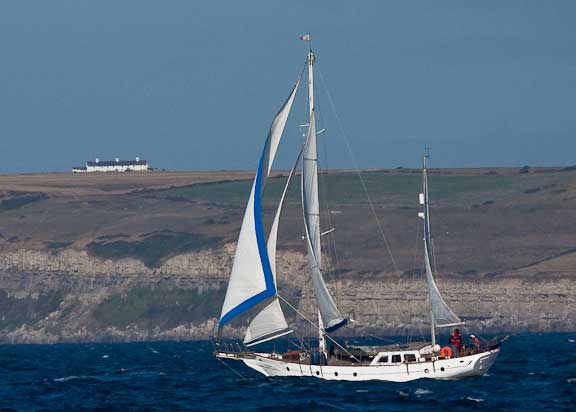
Having spent a lot of miles between the Shetland Islands and Lands End dealing with incessant southwesterlies (on the nose) we were ready for a nice run up the English Channel.
But it was not to be.
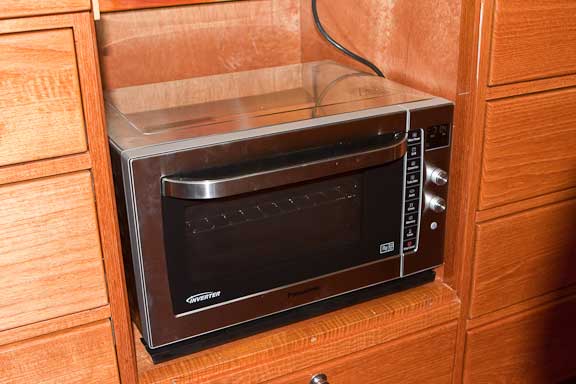
We have just removed our Seaward propane Princess stove and oven. In its place are going a Panasonic WNCF778S combination broiler, microwave, and convection oven, and a Miele CS1212 induction cook top (the latter is intended as a replacement for the temporary induction unit in use aboard for the past 18 months.
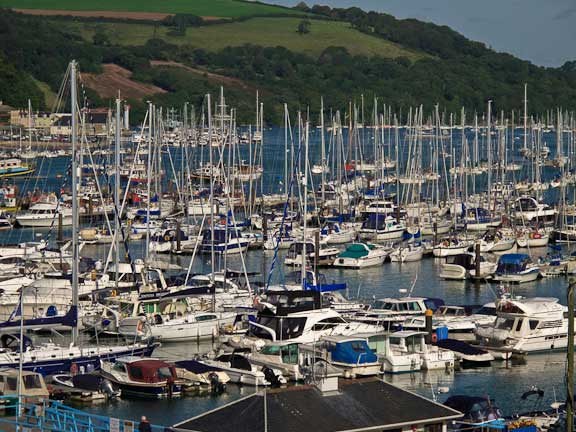
We’ve been hanging out so long now in Dartmouth that our transom is starting to show a small garden. But it is hard to leave. There is a long river to explore with several charming villages, lots to see in town, good restaurants, and for all the tourists about, Dartmouth and its environs have a pleasant ambiance.
The docks and moorings are extremely crowded, but not by the standards of the Solent a little further up the coast. And there is room to anchor. If you look hard you can see Wind Horse in the background just to the right of center.

Every once in a while years of preparation and talent coincide with being in the right place at the right time and you get “lucky”. Such was the case a few days ago when Carol and Mike Parker were cruising in Tonga, and happened to be out on a whale watching boat. Carol is a gifted photographer with a feel for the medium second to none. Getting good photos underwater is unbelievably difficult, and submerged whale photos with detail almost impossible. This collection will make your day. To see Carol’s work check out her blog.
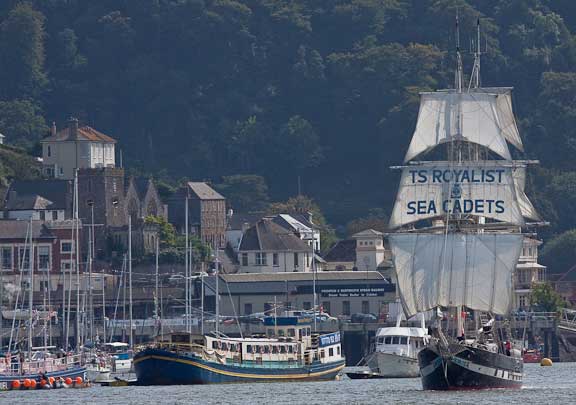
This is one of the compensations for cruising these waters. You see all sorts of wonderful old time vessels (and not a few good looking reproductions). As you may infer from the headline, we’ve been boat watching on the Dart River, a practice in place here for at least a couple of thousand years.